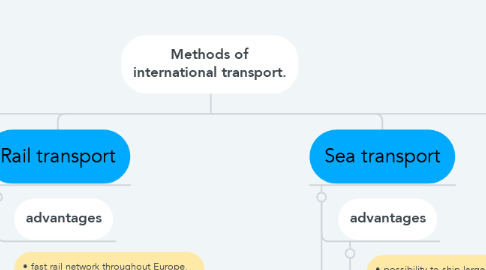
1. Air transport
1.1. advantages
1.1.1. • deliver items quickly over long distances • give high levels of security for sensitive items • be used for a wide range of goods
1.2. risks
1.2.1. • air transport can involve higher costs than other options, and is not suitable for all goods • flights are subject to delay or cancellation • there are taxes to be paid in each airport • fuel and currency surcharges will usually be added to freight costs • further transportation may be needed from the airport to the final destination
2. Sea transport
2.1. advantages
2.1.1. • possibility to ship large volumes at low costs • shipping containers can also be used for further transportation by road or rail
2.2. risks
2.2.1. • shipping by sea can be slower than other transport systems and bad weather can add further delays • routes and timetables are usually inflexible • tracking the goods’ progress is difficult • port duties and taxes • further transportation overland might be needed to reach the final destination • basic freight rates are subject to fuel and currency surcharges
3. Road transport
3.1. advantages
3.1.1. •Low cost •Extensive road networks •Possibility to schedule transport and tracking the location of goods •Safe and private delivery
3.2. risks
3.2.1. •long distances overland can take more time •there can be traffic delays and breakdowns •there is the risk of goods being damaged, especially over long distances •toll charges are high in some countries •different road and traffic regulations on some countries
